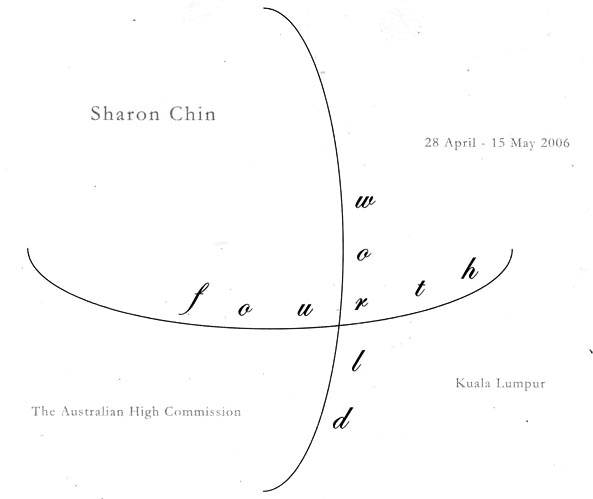Essay published in the catalogue of my solo exhibition Fourth World.
Fourth World by Sharon Chin is an exhibition that proposes we dream within – not out of – our ordinary existence. By creating a sense of wonderment with irritatingly banal materials, the exhibition is a working model of a utopic vision where fantasy and reality generate each other.
The title references existing economic ranks for countries; however, Chin purports that this is not meant to politically charge her discourse. Rather, “fourth world” is her personal term to denote an alternate realm that is ‘close by’ to the familiar: a hyperspace made up of dreams, fantasies and, above all, desire.
Inside, Outside
Driving the exhibition is a struggle for identity, to build on one’s private self despite the overload of ‘experience’ and the world ‘out there’.
The main installation “Mare Clausum (Closed Sea)” is hung overhead in the officious-looking concourse area of the Australian High Commission. It features construction materials, such as green scaffolding mesh and rope, which are transformed into a sweeping suite of illuminated emerald sails.
The green mesh, normally used to cover unfinished buildings, is brought from outside into a building; then its idea is internalized by the artist and finally manifests as a suite of sails, referring back to the world outside. The work is thus engaged in a looped journey.
A similar interplay between the personal ‘inside’ and the world ‘outside’ occurs in supporting artworks located at the periphery of the exhibition space. One of them comprises two series of seven large strips (referring to the seven seas) dipped several times in seawater solution, producing a tonal gradation on each strip while duplicating the effect of undulating waves caressing a beach. The first series “Plastic Shores” is made from perspex boards dipped in a seawater and cement mixture, while the second series “Paper Shores” consists of paper strips dipped in seawater and ink solution.
It seems as though Chin is charting the sea’s slow and gentle yet dramatic sculpting of the coastline, typically investigating the idea of shifting boundaries. The evolving land is metaphorical to fluctuating identity. Moreover, when the paper and perspex supports are placed next to each other – one absorbs ink, the other is clung to – they create a quiet dynamic between acquiescence and resistance.
Mapping Desire
Is it possible to construct a map of desires?
Yes. Such maps already exist in the form of historical maritime maps from the 13th to 17th centuries. Their fanciful illustrations and dedications make today’s maps seem factual and dull. In the 13th century, for instance, the globe was drawn as expanding out from Jerusalem, thought to be the centre of the world. During Ferdinand Magellan’s time, cartographers tended to insert illustrations of sea monsters to indicate unknown and dangerous territories. Rather than mapping the world itself, these maps reveal how their makers desired to view the world.
Likewise, the “Shores” series maps a longing for the world outside, a romance with the unknown. Recorded then on each strip of perspex and paper is the ebb and flow of desire.
The sails in The Fourth World are perpetually in the harbour because Chin is not searching for a utopia elsewhere; she embarks on a passage to the here and now. Hoisted high, the sails seem as hopeful as prayer flags, but are more like flagging prayers. After all, the exhibition is housed in an institution that stands for, among other things, the privilege of access.
Whether one thinks it problematic or suitably paradoxical, The Fourth World works within abjection to create hope; a sort of twisted escape from the inside-in. Desires may be trapped, but they breathe through perforations in the walls.
—-
Lydia Chai is a Malaysian artist and writer, currently residing in Auckland. This essay is © Lydia Chai 2006. All rights reserved.

